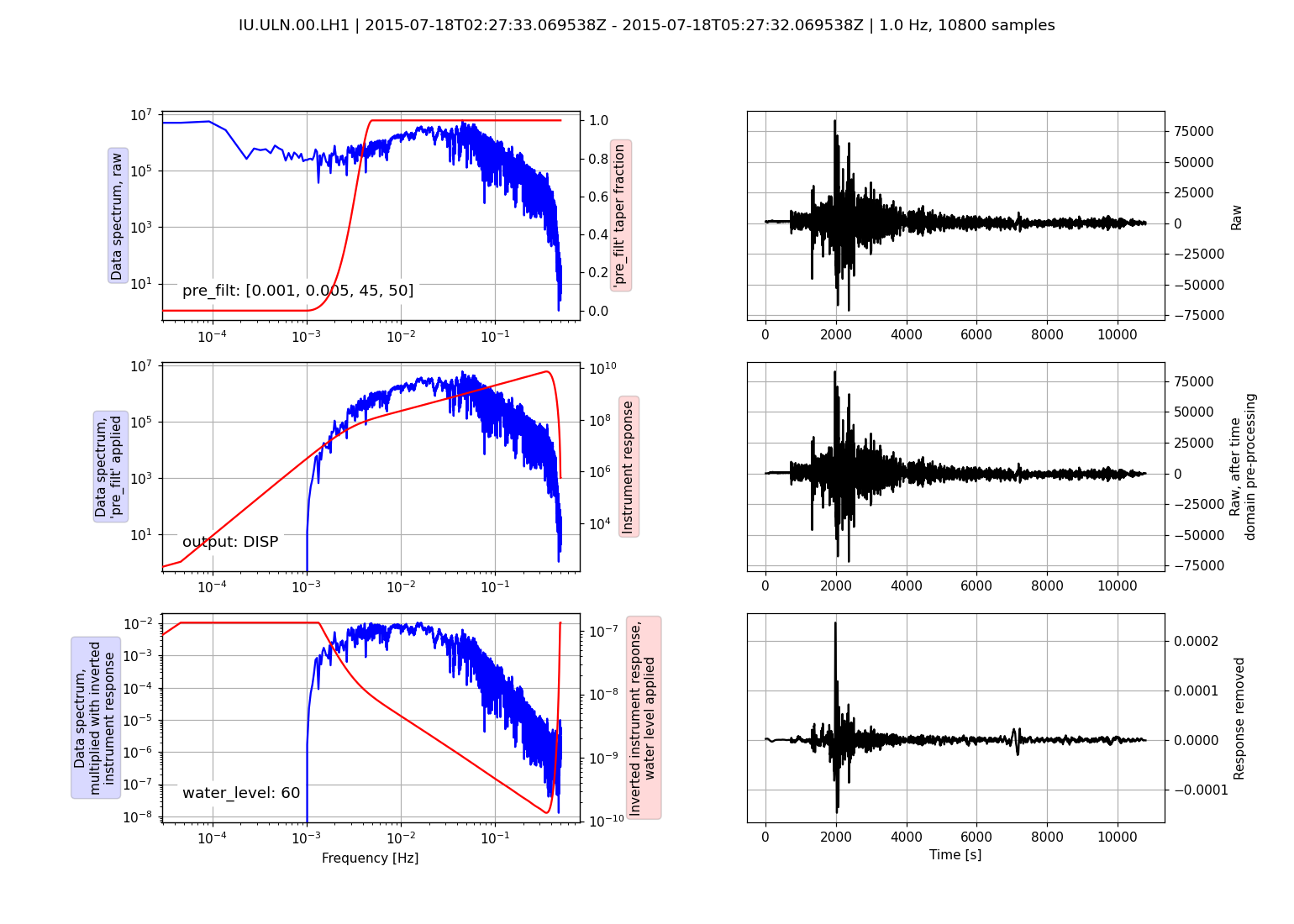obspy.core.trace.Trace.remove_response
- Trace.remove_response(inventory=None, output='VEL', water_level=60, pre_filt=None, zero_mean=True, taper=True, taper_fraction=0.05, plot=False, fig=None, **kwargs)[source]
Deconvolve instrument response.
Uses the adequate
obspy.core.inventory.response.Responsefrom the providedobspy.core.inventory.inventory.Inventorydata. Raises an exception if the response is not present.Note that there are two ways to prevent overamplification while convolving the inverted instrument spectrum: One possibility is to specify a water level which represents a clipping of the inverse spectrum and limits amplification to a certain maximum cut-off value (water_level in dB). The other possibility is to taper the waveform data in the frequency domain prior to multiplying with the inverse spectrum, i.e. perform a pre-filtering in the frequency domain (specifying the four corner frequencies of the frequency taper as a tuple in pre_filt).
Warning
The water level approach can lead to unexpected results that strongly suppress valid/wanted parts of the spectrum if the requested output unit is not the native quantity of the instrument, i.e. the instrument response is not flat for that quantity (e.g. requesting output
"VEL"for an accelerometer). For details see https://github.com/obspy/obspy/issues/3136. In this case it might be better to setwater_level=Noneand usepre_filtoption instead.Note
Any additional kwargs will be passed on to
Response.get_evalresp_response(), see documentation of that method for further customization (e.g. start/stop stage and hiding overall sensitivity mismatch warning).Note
Using
remove_response()is equivalent to usingsimulate()with the identical response provided as a (dataless) SEED or RESP file and when using the samewater_levelandpre_filt(and optionssacsim=Trueandpitsasim=Falsewhich influence very minor details in detrending and tapering).Example
>>> from obspy import read, read_inventory >>> st = read() >>> tr = st[0].copy() >>> inv = read_inventory() >>> tr.remove_response(inventory=inv) <...Trace object at 0x...> >>> tr.plot()
(Source code, png)

Using the plot option it is possible to visualize the individual steps during response removal in the frequency domain to check the chosen pre_filt and water_level options to stabilize the deconvolution of the inverted instrument response spectrum:
>>> from obspy import read, read_inventory >>> st = read("/path/to/IU_ULN_00_LH1_2015-07-18T02.mseed") >>> tr = st[0] >>> inv = read_inventory("/path/to/IU_ULN_00_LH1.xml") >>> pre_filt = [0.001, 0.005, 45, 50] >>> tr.remove_response(inventory=inv, pre_filt=pre_filt, output="DISP", ... water_level=60, plot=True) <...Trace object at 0x...>
(Source code, png)

- Parameters:
inventory (
Inventoryor None.) – Station metadata to use in search for adequate response. If inventory parameter is not supplied, the response has to be attached to the trace withobspy.core.trace.Trace.attach_response()beforehand.output (str) –
Output units. One of:
"DISP"displacement, output unit is meters
"VEL"velocity, output unit is meters/second
"ACC"acceleration, output unit is meters/second**2
"DEF"default units, the response is calculated in output units/input units (last stage/first stage). Useful if the units for a particular type of sensor (e.g., a pressure sensor) cannot be converted to displacement, velocity or acceleration.
water_level (float) – Water level for deconvolution.
pre_filt (list or tuple(float, float, float, float)) – Apply a bandpass filter in frequency domain to the data before deconvolution. The list or tuple defines the four corner frequencies (f1, f2, f3, f4) of a cosine taper which is one between f2 and f3 and tapers to zero for f1 < f < f2 and f3 < f < f4.
zero_mean (bool) – If True, the mean of the waveform data is subtracted in time domain prior to deconvolution.
taper (bool) – If True, a cosine taper is applied to the waveform data in time domain prior to deconvolution.
taper_fraction (float) – Taper fraction of cosine taper to use.
plot (bool or str) – If True, brings up a plot that illustrates how the data are processed in the frequency domain in three steps. First by pre_filt frequency domain tapering, then by inverting the instrument response spectrum with or without water_level and finally showing data with inverted instrument response multiplied on it in frequency domain. It also shows the comparison of raw/corrected data in time domain. If a str is provided then the plot is saved to file (filename must have a valid image suffix recognizable by matplotlib e.g. ‘.png’).